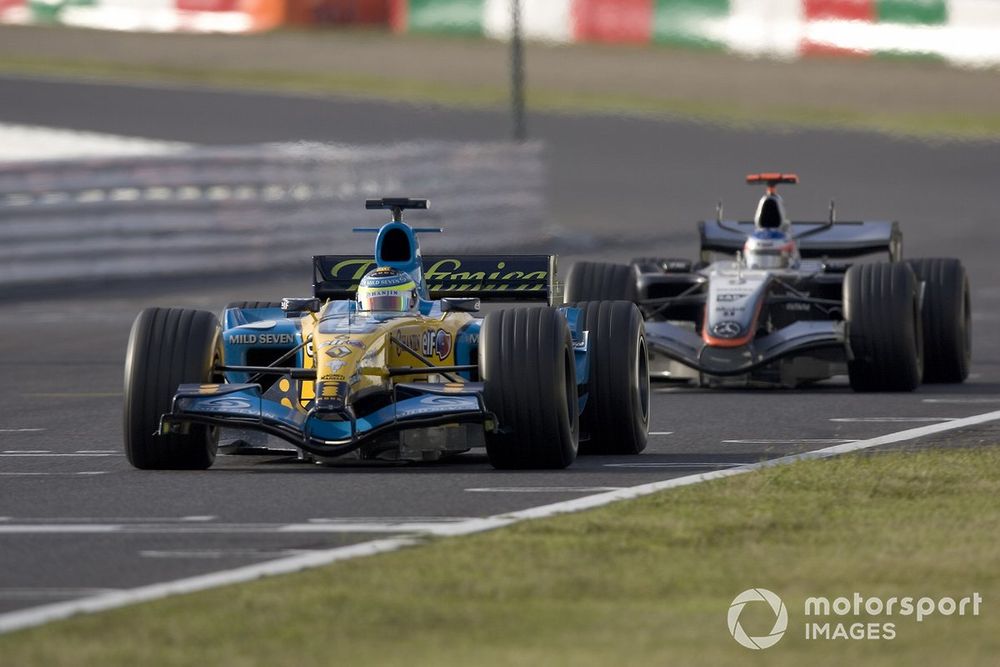They say Suzuka is a drivers’ track, and if that’s the case, then Kimi Raikkonen certainly proved his worth on 9 October 2005.
Coming into the Japanese Grand Prix, 25-year-old Raikkonen had already lost the drivers’ title, with his deficit on new world champion Fernando Alonso having reached 23 points with two races remaining.
One-lap qualifying meant some frontrunners had to deal with late-session rain, and Raikkonen lapped in 2m02.309s, some 16 seconds off the pace; he was going to drop 10 places on the grid anyway, due to an engine penalty.
With Alonso, Raikkonen and his team-mate Juan Pablo Montoya starting from 16th to 18th, it was going to be a race through the pack for the main frontrunners – except second Renault driver Giancarlo Fisichella, who had a significant advantage, starting third behind Toyota’s Ralf Schumacher and BAR-Honda’s Jenson Button.
Alonso had the best opening lap, jumping from 16th to eighth, while Raikkonen gained five places to grab 12th and Montoya crashed out as he found himself on the grass when battling Jacques Villeneuve.
Alonso however found himself stuck behind Michael Schumacher’s Ferrari for 20 laps, while Raikkonen overtook Felipe Massa, Antonio Pizzonia and Villeneuve in quick succession, subsequently passing Christian Klien to find himself seventh, right behind Alonso, on lap 14.
Kimi Raikkonen, McLaren Mercedes MP4/20 passes Michael Schumacher, Ferrari F2005
Photo by: Sutton Images
Although cars followed one another more easily in those days, overtaking was not exactly easy in the pre-DRS era, so Raikkonen overtaking three cars in three laps was nothing ordinary.
Six tours later, Alonso performed a now-famous, sensational move around the outside of Schumacher in 130R, but went on to pit four laps before the Ferrari driver and Raikkonen, who pushed on low fuel and emerged ahead of the Renault.
After Schumacher locked up in the chicane, Raikkonen overtook the seven-time world champion around the outside of the first corner, then cleared Button and Mark Webber in the second round of pitstops.
The Finn was the last driver to pit, on lap 45 out of 53, emerging 5.5s away from race leader Fisichella. Within four laps, Raikkonen brought the gap down to half a second.
Feeling the pressure, Fisichella was much too defensive into the last chicane on the penultimate lap, leaving himself vulnerable on the run down to Turn 1. Raikkonen ruthlessly pounced, snatching a last-gasp triumph which remains widely viewed as his greatest F1 drive.
“I think that was one of my best races ever, with a lot of hard work, and I really enjoyed myself,” Raikkonen said after the race. “Considering all the problems we have had here, to come away with a win is just fantastic.

Giancarlo Fisichella, Renault R25, Kimi Raikkonen, McLaren Mercedes MP4-20
Photo by: Peter Spinney / Motorsport Images
“I was pushing as hard as I could and the car just got better and better. After the second stop I had gained enough on Fisichella to go for it, and I did. I got past him on the last lap coming into the first corner, and it was one of those opportunities you have to take.”
Fisichella added: “The team told me Kimi was close after the last stop, and he caught me up quite quickly – especially when I got chopped by a backmarker into 130R, which cost me a lot of time. He was very fast in the final part of the lap, and I did my best to hold him off, but he held the line into the first corner, and that was that.”
Despite Raikkonen’s victory, Renault’s double podium with Fisichella and Alonso turned the situation around in the constructors’ championship, with the Enstone-based squad now two points ahead instead of behind, with the title decider won by Alonso in China. McLaren would eventually have to wait until 2024 for another constructors’ title.
We want to hear from you!
Let us know what you would like to see from us in the future.
– The Autosport.com Team

